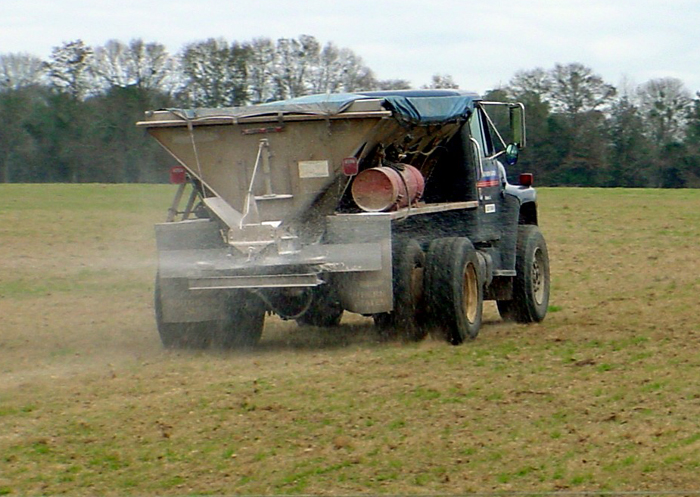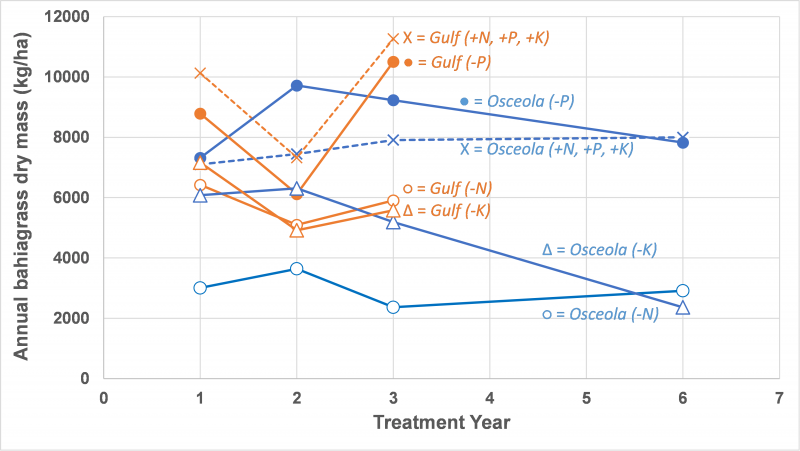
Due to the rapid inflation in input costs, most forage producers have considered cutting back or eliminating fertilizer applications this year. UF research trials documents 36 to 60% yield loss without adequate N application on bahiagrass pastures. Credit: Doug Mayo, UF/IFAS
Cheryl Mackowiak, Soil Scientist, North Florida Research and Education Center, Quincy
Fertilizer prices have flattened or in some cases, declined from the record highs earlier this year. Even so, inflationary pressure continues to make hay and pasture production expensive. Most forage producers have considered either cutting back or eliminating fertilizer applications this year. Should you be concerned about the harm might that this decision might cause? UF/IFAS Researchers conducted a multi-location, multi-year study to help determine what the longer-term impacts are on bahiagrass when individual plant essential nutrients are eliminated from the fertilizer. Our longest duration on-farm location is in Osceola County (6 years), while three other sites, including one in Gulf County, have been under study for three years. Two locations will be used to help illustrate bahiagrass herbage response to slowly depleted nutrients from the soil.
–
Osceola County
Average annual forage or herbage production (dry matter basis) for bahiagrass receiving ample nitrogen (N at 160 lbs/acre/season), phosphorus (P2O at 80 lbs/acre/season) and potassium (K2O at 160 lbs/acre/season) (+N, +P, +K) was approximately 7,500 kg ha-1 (6,700 lbs acre-1) across all 6 years (Figure 1). As expected, eliminating N (-N) depressed herbage yield by nearly 60% within the first season. The relative hit in yield remained at this level during the six years of this study. In comparison, eliminating K from the fertilizer (-K), resulted in only modest herbage decline (< 15%) for the first two seasons, but by the third year, forage mass had slipped by nearly 35% and over 60% by the sixth year, which led to harvests as low as if no N was applied. Somewhat surprisingly, the treatment without P replacement (-P) resulted in herbage production as good or greater than the complete fertilizer treatment, even after six years (Figure 1).

Figure 1. The impact of eliminating specific (N, P, or K) plant essential nutrients from bahiagrass fertilizer applications over multiple years at two on-farm locations, Osceola County (6 years) and Gulf County (3 years). Complete mineral fertilizer treatment = +N, +P, +K; treatment without N = -N; treatment without P = -P; treatment without K = -K. All other nutrients were replenished at each fertilization (two times per season).
–
Gulf County
The trial in Gulf County is entering its fourth year. Results were somewhat similar to the first three years of the Osceola testing, where the treatment without P (-P) performed similarly (within 10% through year 3) to the complete fertilization treatment (+N, +P, +K) treatment (Figure 1). Unlike Osceola County, the lack of N fertilization depressed herbage values by only 36% in the first season (from approximately 10,000 to 6,400 kg ha-1 (8,900 to 5,700 lbs acre-1). However, by the third year, herbage dry mass was only 48% of the complete fertilizer control. Unlike Osceola County where K impact was more gradual through the first three years, in Gulf County deleting K depressed herbage production at the same rate as deleting N from the fertilizer.
The time that elapsed before yields were significantly impacted with each nutrient tested varied to a minor extent between test sites, and this likely relates to soil type and textural differences, as well as soil fertility at the time the testing was initiated. For example, Gulf County has a heavier texture soil than the Osceola site, which may help explain why N depletion was not as severe in Gulf County over the first couple of seasons, compared to Osceola County. Sometimes differences cannot be explained by soil fertility alone. For example, soil K values were similarly low at both locations within the first year (< 35 ppm K) but tissue K was approximately 0.8% at Osceola County and 0.35% in Gulf County. This demonstrates the potential benefit of including tissue testing with your soil sampling, if you suspect nutrient deficiencies or imbalances.
–
Take Home Message
Based upon our results to date, a few take-home messages might help when you are trying to decide how to trim bahiagrass fertilization costs:
- You will lose herbage yield (our study showed anywhere from 36 to 60%) within the first season without adequate N application rates (50 lbs acre-1 or more).
- If you cut back (or eliminate) N fertilization significantly (IFAS low N management pasture option), it is likely that P and K can also be eliminated, as well. Yields will be low but nutrient imbalances are less likely, as well.
- If your soil report shows low K, you might benefit from a recommended K application during the same season, but depressed yields will become significantly worse by the third season, if nothing is done to correct the deficiency. This was observed at all locations. At this point, the weakened plants are also more susceptible to both leaf and root fungal diseases.
- The P recommendations for bahiagrass, based upon the recommended IFAS tissue critical value of 0.15% (for bahiagrass), appears adequate, based upon our multi-location, on-farm results so far. However, the soil P test critical low value appears less consistently correlated with plant tissue concentrations, so if you suspect inadequate P fertility, test the forage, along with the soil, as is recommended by UF/IFAS soil testing
- Based on our multi-location Florida trials, P may be the one nutrient you can eliminate from your fertilizer for at least one or two seasons, if cost-savings are critical to you. Exceptions include recently converted pine plantation land and perhaps fields dedicated entirely to hay or sod production, where a relatively large portion of nutrients are being exported off the field through either hay or sod. As always, your least expensive investment regarding fertilization is to sample your soil and plants ahead of ordering your fertilizer (once a year). Knowing is much better than guessing!
- If you are interested in sampling plants for tissue analysis, it is preferable to collect tissue samples during young, active growth periods (early to mid-summer), rather than late season and especially not during dormancy. Contact your local extension office for more information.
- Grower Survey Insights on Cotton Nitrogen Management in Florida’s Panhandle - July 18, 2025
- Florida Soils are an Indispensable Natural Resource - January 10, 2025
- Regenerative Agriculture: What it Means to You - June 21, 2024
